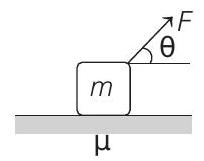Laws of Motion 3 Question 21
22. A block of mass
(1987, 7M)
Show Answer
Answer:
Correct Answer: 22.
Solution:
- Let
Normal reaction in this case will be,

The limiting friction is therefore
For the block to move,
For
Substituting this value of






